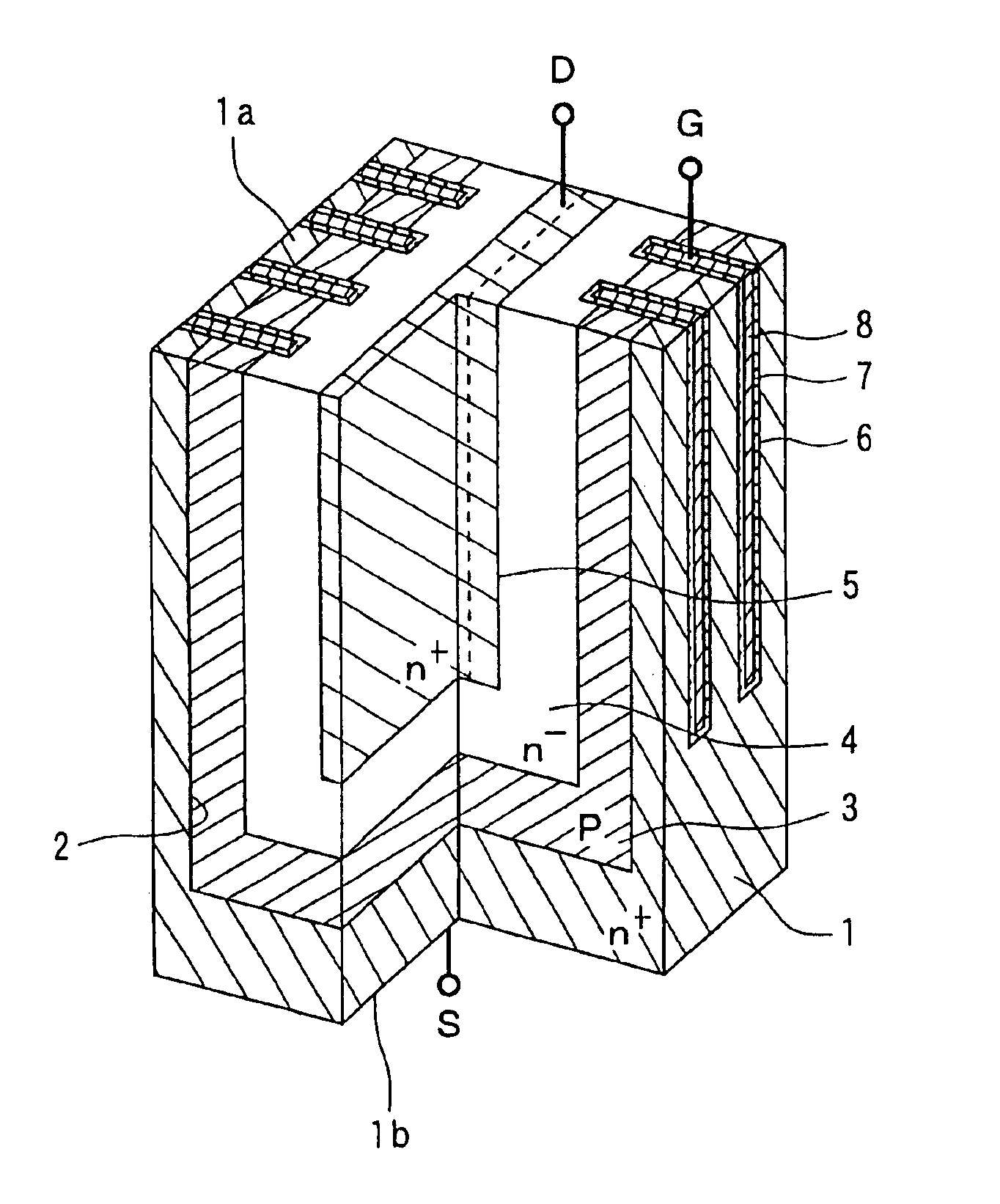Semiconductor device having high breakdown voltage without increased on resistance
a technology of semiconductors and transistors, applied in the direction of semiconductor devices, electrical equipment, transistors, etc., can solve the problems of reducing the area of the channel and enlarge the size of the devi
- Summary
- Abstract
- Description
- Claims
- Application Information
AI Technical Summary
Benefits of technology
Problems solved by technology
Method used
Image
Examples
first embodiment
The structure of a power MOSFET in a first embodiment of the present invention will be described with reference to FIG. 1. In FIG. 1, the power MOSFET is fabricated from an n+-type substrate 1 having a top surface 1a, or main surface, and a back surface 1b, which is opposite to the top surface 1a. The substrate 1 forms an n+-type (first conduction type) source region that is homogeneously doped with any of phosphorus (P), arsenic (As), and antimony (Sb), which are n-type impurities, with a concentration ranging between 1×1018 and 1×1020 cm−3. A trench 2 (first trench) is formed in the substrate 1 with a predetermined depth from the top surface 1a. The depth ranges, for example, between 1 and 100 micrometers. A p-type (second conduction type) base region 3 having a thickness ranging between 0.1 and 5 micrometers is formed in the trench 2. The base region 3 is homogeneously doped with B (boron), which is a p-type impurity, with a concentration ranging between 1×1015 and 1×1018 cm−3. A...
second embodiment
As shown in FIG. 4, a power MOSFET according to a second embodiment includes an embedded metal layer 20, which electrically connects the n+-type source region 1 and the p-type base region 3 to apply the same potential to the n+-type source region 1 and the p-type base region 3. In the power MOSFET according to the first embodiment, the n+-type source region 1 and the p-type base region 3 are electrically connected using a metal wiring 25, as shown in FIG. 5. To connect the n+-type source region 1 and the p-type base region 3, a plurality of contact holes are formed in the interlayer insulating film and the metal wiring 25 is located in the contact hole. Therefore, the layout of the drain electrode is limited by the wiring 25. However, according to the second embodiment, this limitation is avoided by forming the metal layer 20.
third embodiment
As shown in FIG. 6, a power MOSFET according to a third embodiment includes a first embedded metal layer 20, the depth of which is close to that of the drain region 5, and a second embedded metal layer 21 located in the drain region 5. The depth of the second embedded metal layer 21 is close to that of the first embedded metal layer 20. With this structure, the resistances of the n+-type source region 1 and the drain region 5 are reduced. The power MOSFET in this embodiment is manufactured by forming a plurality of trenches extending from the top surface 1a at a boundary between the n+-type source region 1 and the p-type base region 3 and in the region 5 after the process shown in FIG. 3E. Then, the trenches are filled with the metal layers 20 and 21.
PUM
 Login to View More
Login to View More Abstract
Description
Claims
Application Information
 Login to View More
Login to View More - R&D
- Intellectual Property
- Life Sciences
- Materials
- Tech Scout
- Unparalleled Data Quality
- Higher Quality Content
- 60% Fewer Hallucinations
Browse by: Latest US Patents, China's latest patents, Technical Efficacy Thesaurus, Application Domain, Technology Topic, Popular Technical Reports.
© 2025 PatSnap. All rights reserved.Legal|Privacy policy|Modern Slavery Act Transparency Statement|Sitemap|About US| Contact US: help@patsnap.com



